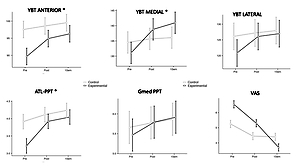Current issue
Archive
Manuscripts accepted
About the Journal
Editorial office
Editorial board
Section Editors
Abstracting and indexing
Subscription
Contact
Ethical standards and procedures
Most read articles
Instructions for authors
Article Processing Charge (APC)
Regulations of paying article processing charge (APC)
ORTHOPEDICS AND TRAUMATOLOGY / RESEARCH PAPER
Effects of dry needling in gluteus medius muscle in individuals with chronic ankle instability: a randomized single-blinded controlled clinical trial
1
Department of Physiotherapy, University of Seville, Avicena Street, 41009, Seville, Spain., Spain
2
Faculty of Sport Sciences, Universidad Europea de Madrid, Villaviciosa de Odón 28670, Spain., Spain
3
Facultad de Enfermería, Fisioterapia y Podología, Universidad Complutense de Madrid, 28040 Madrid, Spain, Spain
4
Frailty Research Organized Group (FROG), Department of Nursing, Faculty of Nursing and Podiatry, University of Valencia, 46001 Valencia, Spain., Spain
5
Department of Physical Therapy, University of Alcalá, 28805 Alcalá de Henares, Spain, Spain
Submission date: 2021-09-11
Final revision date: 2021-10-19
Acceptance date: 2021-11-28
Online publication date: 2021-12-14
Corresponding author
Carlos Romero-Morales
Faculty of Sport Sciences, Universidad Europea de Madrid, Villaviciosa de Odón 28670, Spain., Spain
Faculty of Sport Sciences, Universidad Europea de Madrid, Villaviciosa de Odón 28670, Spain., Spain
KEYWORDS
TOPICS
ABSTRACT
Introduction:
Background: Lateral ankle sprain (LAS) is the most common musculoskeletal injuries in sport and general population. The goal of the present study was to observe the effectiveness of dry needling (DN) in gluteus medius muscle in patients with chronic ankle instability (CAI).
Material and methods:
A two-arm (1:1), single-blinded (participants), randomized clinical trial was performed in 40 subjects with chronic ankle instability and were divided in two groups: intervention group who received one session of dry needling in the most hyperalgesic gluteus medius myofascial trigger point (MTrP), (n = 20) and control group (n = 20). Dynamic balance, pain intensity, pain pressure threshold (PPT) and ankle dorsiflexion range of motion (ROM) were assessed at baseline, post-intervention and a 1-week follow up.
Results:
The experimental group reported significant differences with respect to the control group for the anterior and medial dynamic balance (p = .001), PPT -ATL (p = .002) and ankle dorsiflexion ROM (p = .001).
Conclusions:
The findings of the present study suggested that the DN in the most hyperalgesic MTrP of the Gmed muscle may increase the anterior and medial dynamic balance, ankle ROM and PPT-ATL at short-term in individuals with CAI. Pain intensity benefits were reported in both groups. Future studies should consider DN as a possible intervention in conjunction with a physical therapy program for individuals with CAI.
Background: Lateral ankle sprain (LAS) is the most common musculoskeletal injuries in sport and general population. The goal of the present study was to observe the effectiveness of dry needling (DN) in gluteus medius muscle in patients with chronic ankle instability (CAI).
Material and methods:
A two-arm (1:1), single-blinded (participants), randomized clinical trial was performed in 40 subjects with chronic ankle instability and were divided in two groups: intervention group who received one session of dry needling in the most hyperalgesic gluteus medius myofascial trigger point (MTrP), (n = 20) and control group (n = 20). Dynamic balance, pain intensity, pain pressure threshold (PPT) and ankle dorsiflexion range of motion (ROM) were assessed at baseline, post-intervention and a 1-week follow up.
Results:
The experimental group reported significant differences with respect to the control group for the anterior and medial dynamic balance (p = .001), PPT -ATL (p = .002) and ankle dorsiflexion ROM (p = .001).
Conclusions:
The findings of the present study suggested that the DN in the most hyperalgesic MTrP of the Gmed muscle may increase the anterior and medial dynamic balance, ankle ROM and PPT-ATL at short-term in individuals with CAI. Pain intensity benefits were reported in both groups. Future studies should consider DN as a possible intervention in conjunction with a physical therapy program for individuals with CAI.
Share
RELATED ARTICLE
We process personal data collected when visiting the website. The function of obtaining information about users and their behavior is carried out by voluntarily entered information in forms and saving cookies in end devices. Data, including cookies, are used to provide services, improve the user experience and to analyze the traffic in accordance with the Privacy policy. Data are also collected and processed by Google Analytics tool (more).
You can change cookies settings in your browser. Restricted use of cookies in the browser configuration may affect some functionalities of the website.
You can change cookies settings in your browser. Restricted use of cookies in the browser configuration may affect some functionalities of the website.



